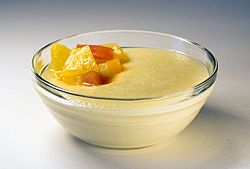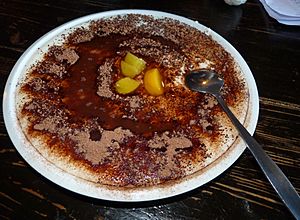Semolina pudding facts for kids

Semolina pudding with fruits
|
|
| Alternative names | kasza manna, krupičná kaše, krupicová kaša, griș cu lapte, tejbegríz, Grießbrei, Mamonia |
|---|---|
| Type | Pudding, porridge |
| Region or state | Central and Eastern Europe |
| Serving temperature | Warm or chilled |
| Main ingredients | Semolina, milk, sugar |
| Variations | Water instead of milk |
Semolina pudding or semolina porridge is a yummy dish that's a bit like porridge or pudding. It's made from semolina, which is a special kind of flour. You cook semolina with milk, or sometimes a mix of milk and water, or even just water.
People often serve semolina pudding with tasty toppings. These can include sugar, cocoa powder, cinnamon, raisins, fresh fruit, or sweet syrup. If you use more semolina and bake it instead of boiling, it can become thick like rice pudding.
Contents
What is Semolina?
Semolina is a coarse flour. It is made from durum wheat. Durum wheat is a very hard type of wheat. This flour is often used to make pasta. It gives semolina pudding its unique texture.
A Bit of History
Semolina pudding has been enjoyed for a very long time! People in Europe have been eating it since the time of the ancient Romans. An old recipe book called Apicius, from around 400 AD, describes a semolina porridge. This ancient recipe mixed semolina with almonds, raisins, and even raisin wine.
Instant Pudding
Today, you can also buy semolina pudding as an instant mix. This means it comes in a powder. You just add milk or water to make it. These instant versions often have extra flavors. They might include cream, vanilla, fruit, or other flavorings. If the mix only needs water, it usually has powdered milk already in it.
Semolina Pudding Around the World
Many countries have their own special ways of making and serving semolina pudding. It's a popular comfort food in different cultures.
Czech Republic, Slovakia, and Austria
In the Czech Republic, people call it krupičná kaše or krupicová kaše. In Slovakia, it's known as krupicová kaša. And in Austria, they say Grießkoch. It's always served warm. People sprinkle it with cocoa and sugar. Then, they pour melted butter over the top. Sometimes, they add other flavors like cinnamon, honey, or grated chocolate.
Romania
In Romania, this dish is called griș cu lapte. People often add jam, candied fruit, cinnamon, and raisins to it. After it's cooked, they might pour it into a cake pan. It can be eaten warm or cold. The Romanian word griș is similar to the German word Grieß, which means grit.
Hungary
Hungarians call this dish tejbegríz or tejbedara. This means "semolina into the milk." It's usually cooked with lots of sugar, some butter, and a tiny bit of salt. They serve it warm. You can eat it plain, or with cocoa powder or cinnamon sugar. Fresh or canned fruits, jam, vanilla, or chocolate bits are also popular toppings. Some modern additions include ice cream, whipped cream, brown sugar, maple syrup, candied fruit, or pumpkin seeds.
Lithuania
In Lithuania, this dish is called manų košė. It's usually cooked with a mix of water, milk, and sugar. It's always served warm. People top it with cinnamon and sugar, or sometimes jam.
Syria
This dish is very well known in Damascus and Aleppo in Syria. It's called Mamonia there. To make it, semolina is first toasted in butter. Then, it's added to boiling water mixed with sugar. Sometimes, pieces of cinnamon are added too. Mamonia is served with different toppings. These can include white cheese, cinnamon powder, and pistachios.
See also
 In Spanish: Gacha de sémola para niños
In Spanish: Gacha de sémola para niños


